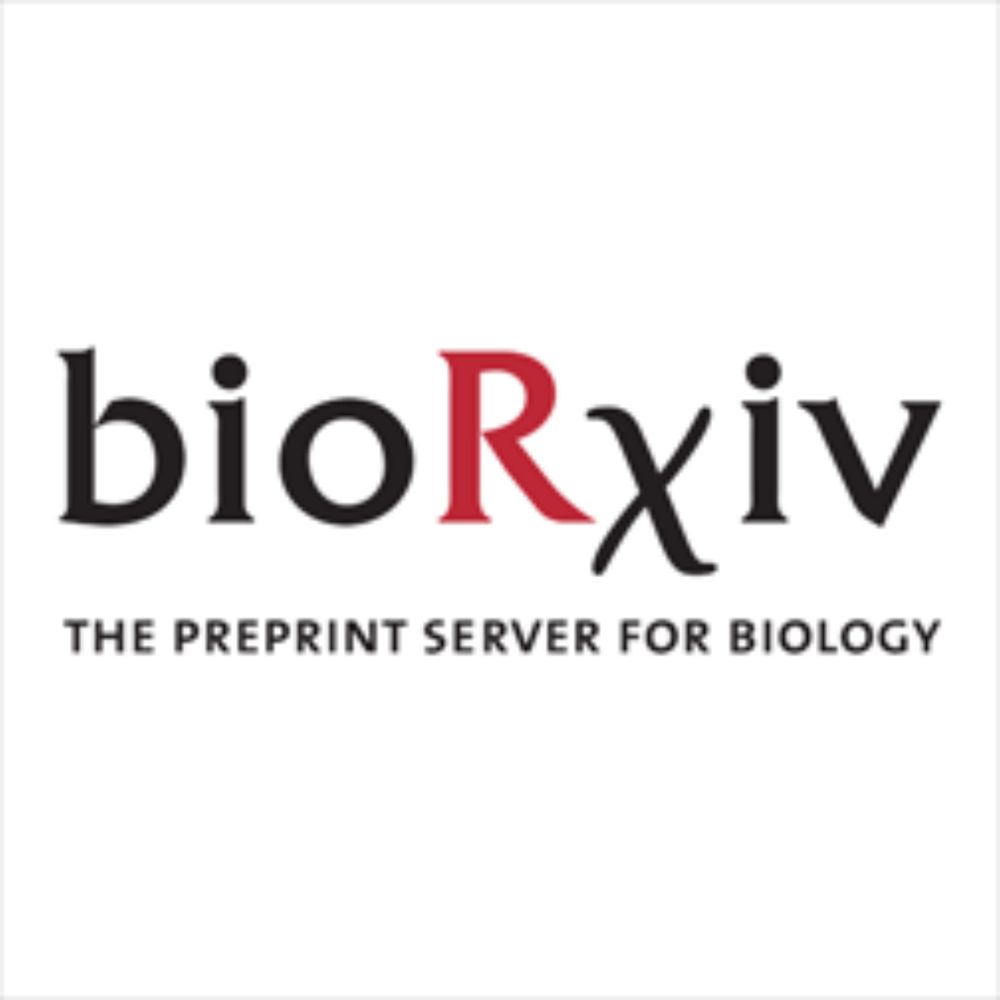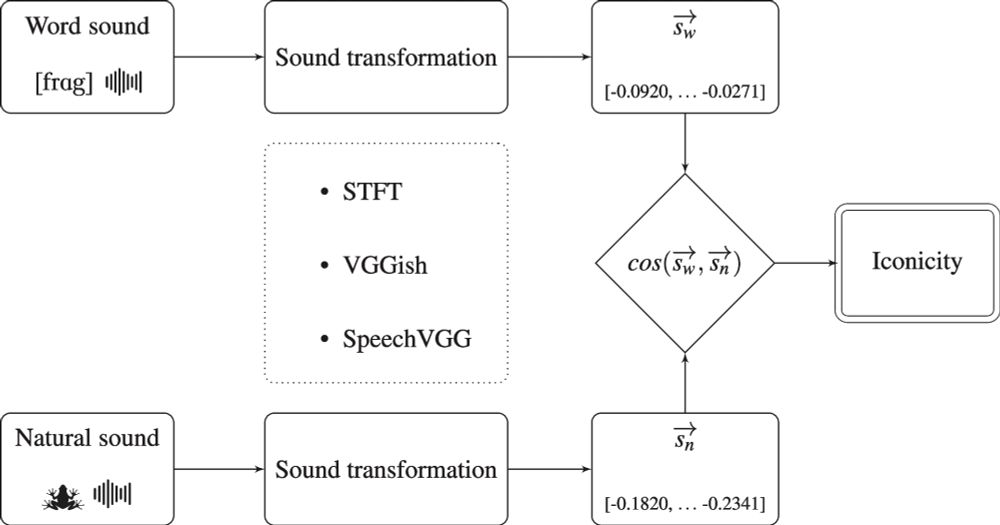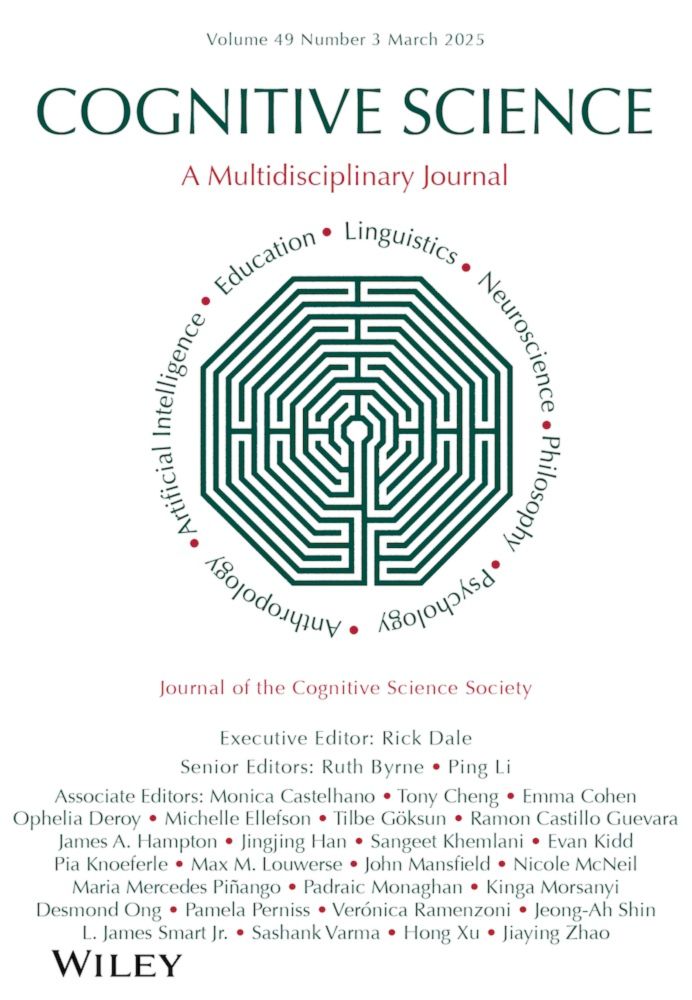
Can't wait for #CCN2025! Drop by to say hi to me / collaborators!
10.08.2025 16:52 — 👍 26 🔁 1 💬 0 📌 0
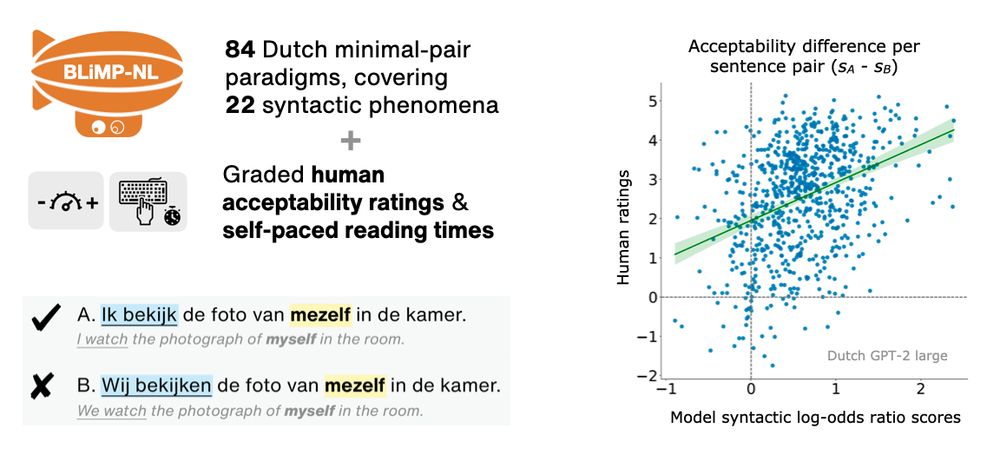
The BLiMP-NL dataset consists of 84 Dutch minimal pair paradigms covering 22 syntactic phenomena, and comes with graded human acceptability ratings & self-paced reading times.
An example minimal pair:
A. Ik bekijk de foto van mezelf in de kamer (I watch the photograph of myself in the room; grammatical)
B. Wij bekijken de foto van mezelf in de kamer (We watch the photograph of myself in the room; ungrammatical)
Differences in human acceptability ratings between sentences correlate with differences in model syntactic log-odds ratio scores.
Next week I’ll be in Vienna for my first *ACL conference! 🇦🇹✨
I will present our new BLiMP-NL dataset for evaluating language models on Dutch syntactic minimal pairs and human acceptability judgments ⬇️
🗓️ Tuesday, July 29th, 16:00-17:30, Hall X4 / X5 (Austria Center Vienna)
24.07.2025 15:30 — 👍 28 🔁 4 💬 2 📌 2

I'm sharing a Colab notebook on using large language models for cognitive science! GitHub repo: github.com/MarcoCiappar...
It's geared toward psychologists & linguists and covers extracting embeddings, predictability measures, comparing models across languages & modalities (vision). see examples 🧵
18.07.2025 13:39 — 👍 9 🔁 4 💬 1 📌 0
Many LM applications may be formulated as text generation conditional on some (Boolean) constraint.
Generate a…
- Python program that passes a test suite.
- PDDL plan that satisfies a goal.
- CoT trajectory that yields a positive reward.
The list goes on…
How can we efficiently satisfy these? 🧵👇
13.05.2025 14:22 — 👍 11 🔁 6 💬 1 📌 0

The cerebellar components of the human language network
The cerebellum's capacity for neural computation is arguably unmatched. Yet despite evidence of cerebellar contributions to cognition, including language, its precise role remains debated. Here, we sy...
New paper! 🧠 **The cerebellar components of the human language network**
with: @hsmall.bsky.social @moshepoliak.bsky.social @gretatuckute.bsky.social @benlipkin.bsky.social @awolna.bsky.social @aniladmello.bsky.social and @evfedorenko.bsky.social
www.biorxiv.org/content/10.1...
1/n 🧵
21.04.2025 15:19 — 👍 49 🔁 20 💬 2 📌 3
APA PsycNet
PINEAPPLE, LIGHT, HAPPY, AVALANCHE, BURDEN
Some of these words are consistently remembered better than others. Why is that?
In our paper, just published in J. Exp. Psychol., we provide a simple Bayesian account and show that it explains >80% of variance in word memorability: tinyurl.com/yf3md5aj
10.04.2025 14:38 — 👍 40 🔁 14 💬 1 📌 0

New preprint w/ @jennhu.bsky.social @kmahowald.bsky.social : Can LLMs introspect about their knowledge of language?
Across models and domains, we did not find evidence that LLMs have privileged access to their own predictions. 🧵(1/8)
12.03.2025 14:31 — 👍 60 🔁 16 💬 2 📌 4
In conclusion, our results show that (1) LMs are broadly applicable models of the human language system across languages, and (2) there is a shared component in the processing of different languages (14/14)
04.02.2025 18:03 — 👍 2 🔁 0 💬 0 📌 0
Languages greatly vary in form, but there is a massive overlap in the concepts they can express. We speculate that this shared meaning space is responsible for successful encoding transfer, but we’ll look more into this in future work (13/)
04.02.2025 18:03 — 👍 0 🔁 0 💬 1 📌 0
What supports the transfer of the encoding models? Form and meaning are two promising candidates. However, form-based (phonological, phonetic, syntactic) language similarity does not predict transfer performance (12/)
04.02.2025 18:03 — 👍 0 🔁 0 💬 1 📌 0
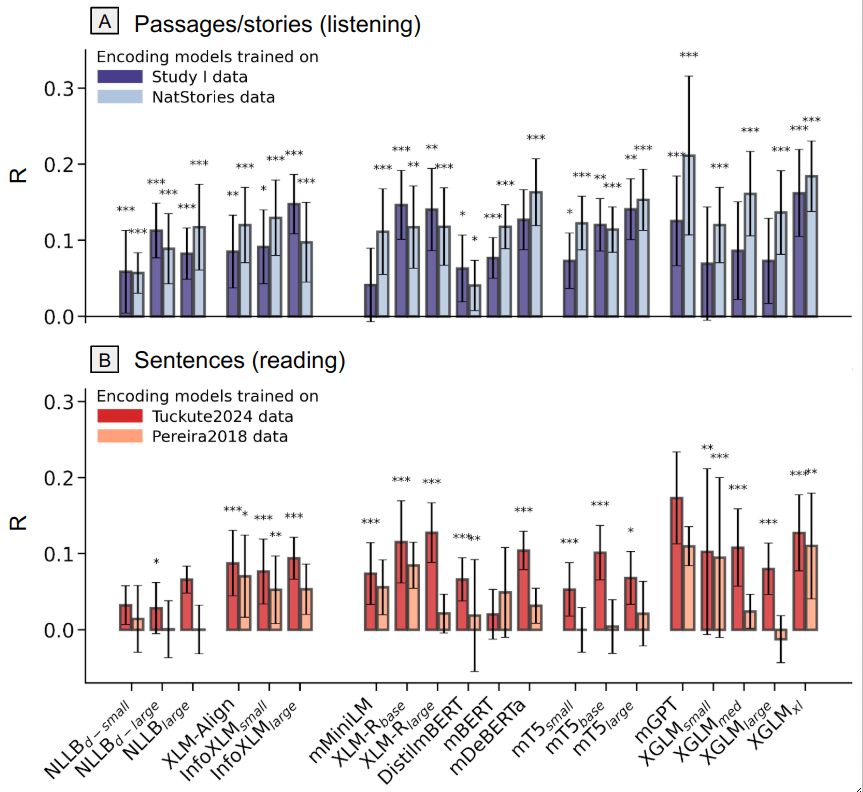
Encoding models trained on existing fMRI datasets successfully predicted responses in new languages, generalizing across stimuli types and modalities (11/)
04.02.2025 18:03 — 👍 0 🔁 0 💬 1 📌 0
In Study II, we tested transfer in a more stringent condition: training encoding models on existing fMRI datasets (sentence reading: Pereira2018, Tuckute2024; passage listening: Study I data, NatStories) and testing them on newly collected fMRI data in 9 new languages (10/)
04.02.2025 18:03 — 👍 0 🔁 0 💬 1 📌 0
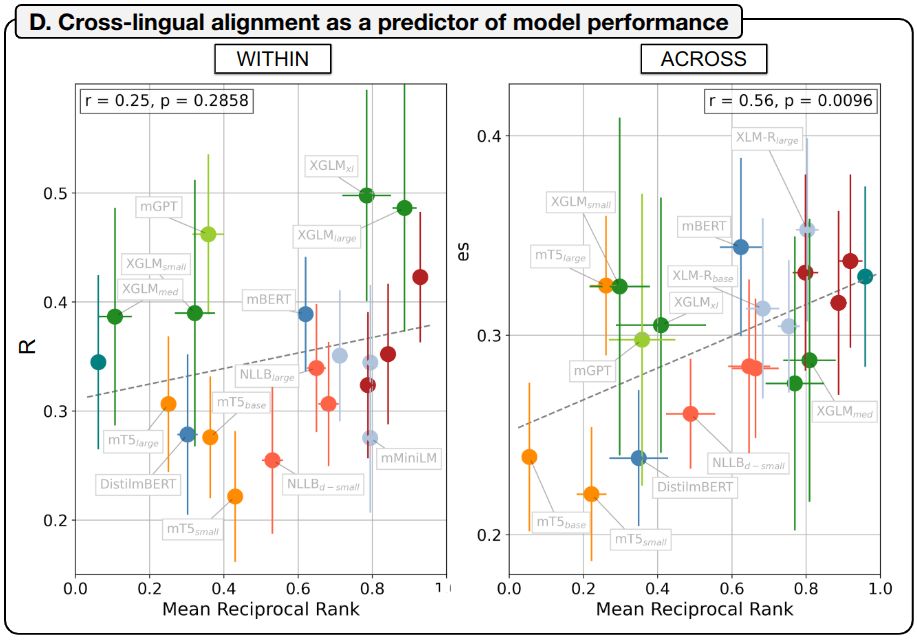
In the “across” condition, performance improves for models with stronger cross-lingual semantic alignment (where translations cluster together in the embedding space) (9/)
04.02.2025 18:03 — 👍 0 🔁 0 💬 1 📌 0
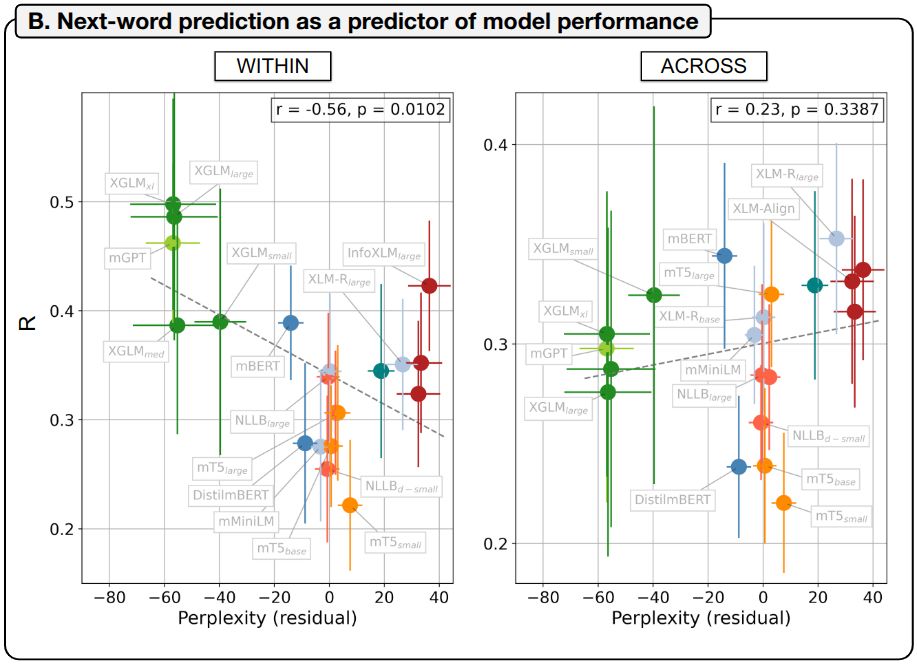
But what kind of model properties influence LM-to-brain alignment across languages?
In the “within” condition, encoding performance is highest for models with good next-word prediction abilities (8/)
04.02.2025 18:03 — 👍 0 🔁 0 💬 1 📌 0
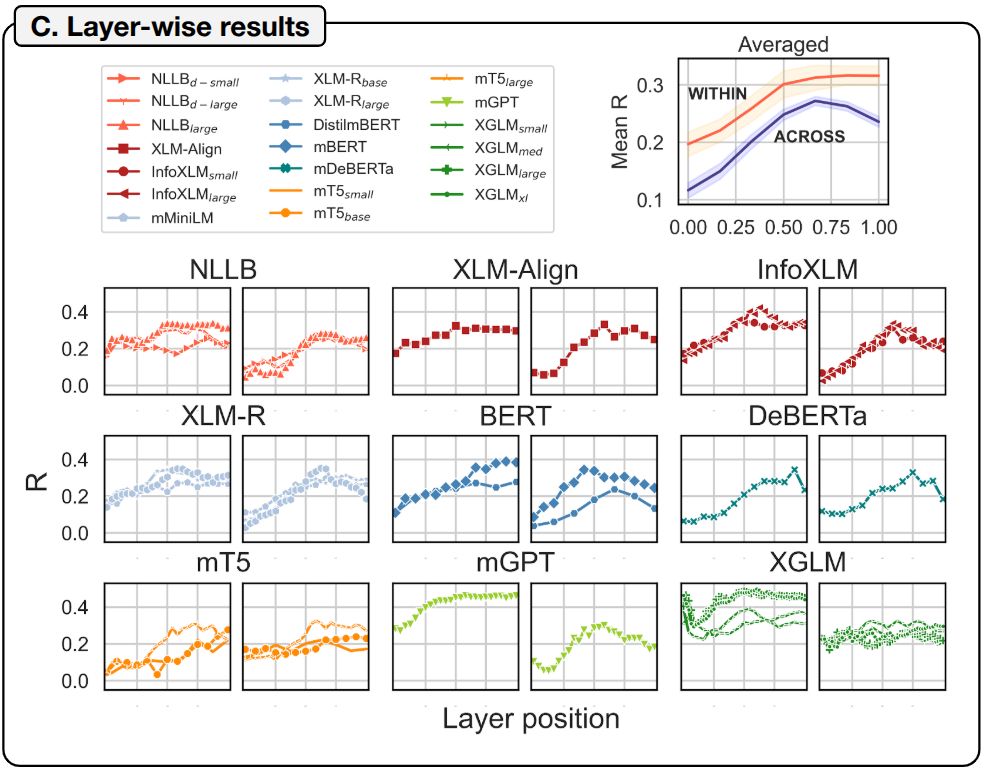
We also replicated in a cross-lingual setting the finding that the best fit to brain responses is obtained in intermediate-to-deep layers (for each subplot pair, the left one is “within”, the right one “across”) (7/)
04.02.2025 18:03 — 👍 0 🔁 0 💬 1 📌 0
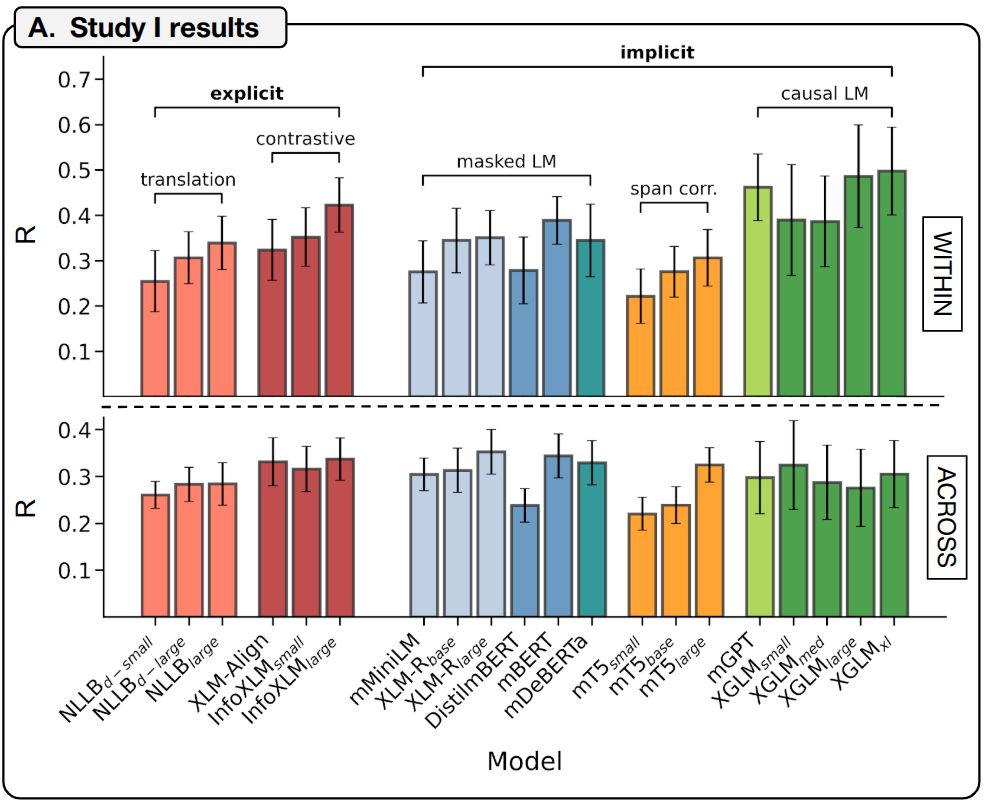
We evaluated 20 multilingual LMs with different architectures and training objectives, and all of them were able to predict brain responses in the various languages (“within”) and critically, generalized zero-shot to unseen languages (“across”) (6/)
04.02.2025 18:03 — 👍 0 🔁 0 💬 1 📌 0
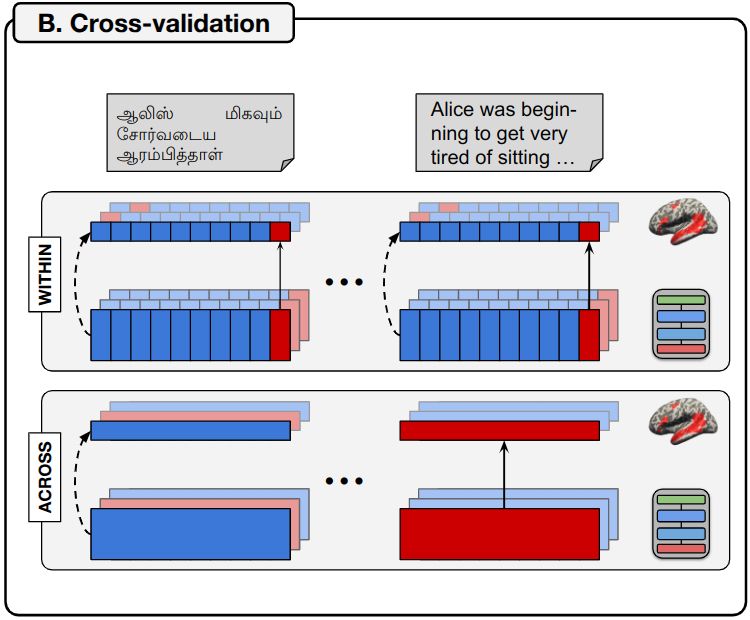
Critically, we fit two kinds of encoding models:
1️⃣ “within” encoding models, training and testing on data from a single language with cross-validation
2️⃣ “across” encoding models, training in N-1 languages and testing in the left-out language (5/)
04.02.2025 18:03 — 👍 0 🔁 0 💬 1 📌 0
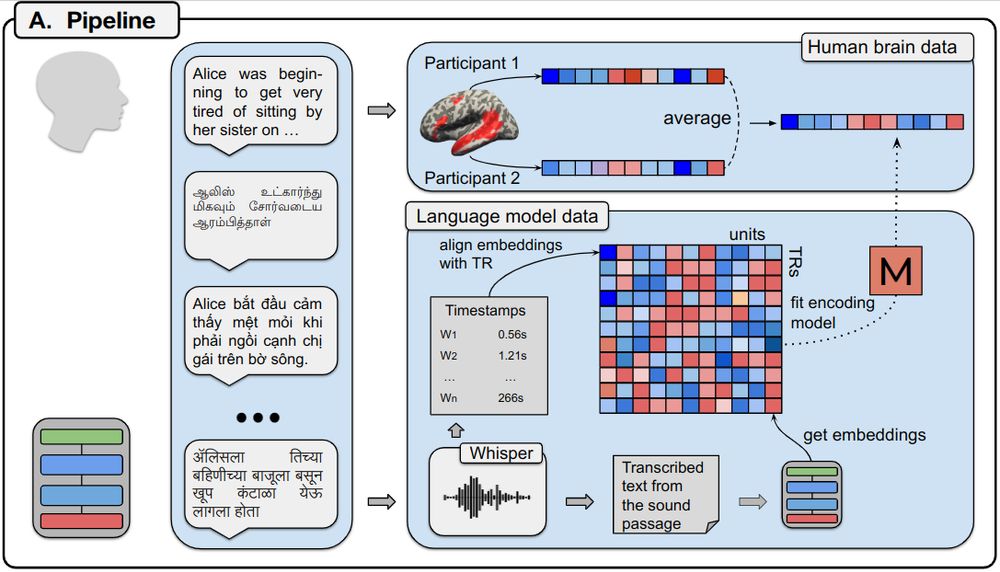
In Study I, we:
1️⃣ Present participants with auditory passages and record their brain responses in the language network
2️⃣ Extract contextualized word embeddings from multilingual LMs
3️⃣ Fit encoding models predicting brain activity from the embeddings (4/)
04.02.2025 18:03 — 👍 0 🔁 0 💬 1 📌 0
We address these questions through two studies, combining existing (12 languages, 24 participants) and newly collected fMRI data (9 languages, 27 participants). (3/)
04.02.2025 18:03 — 👍 0 🔁 0 💬 1 📌 0
We ask two core questions:
1️⃣ Does the LM-brain alignment generalize to typologically diverse languages?
2️⃣ Are brain representations similar across languages? (2/)
04.02.2025 18:03 — 👍 0 🔁 0 💬 1 📌 0
Post-Doc CogSci @Sapienza University of Rome @ballabrome.bsky.social. Interested in concepts, language, culture, and perception; soft spot for #rstats, #OpenScience, gender studies & dinosaurs🏳️🌈
Doctoral Candidate at MPS Cog, MPI for math and MPI cybernetics. Previous stints at CIMEC, Oracle and IISc Bangalore. Decision-making and machines.
More at debottamKundu.github.io
🧠🧠🧠
(Bologna), Udine, London, Padova, Trento, Leipzig. Now approaching neurolinguistics and network neuroscience at @IUSSPavia.
Postdoc at @theneuro.bsky.social | semantic knowledge, socialness & cognitive control 🧠 💭🫂 | OHBM Open Science SIG Treasurer | McGill Postdoc Assoc. Chair
Postdoc @ MIT Brain & Cognitive Science | PhD @ YalePsychology | Computational Modeling | Metacognition | Social Cognition | Perception | Women’s Health Advocacy marleneberke.github.io
The Yang Tan Collective accelerates collaboration in basic science, research, and engineering to realize translative strategies and technologies that achieve a healthy mind in a healthy body and improve human wellbeing at a global scale. yangtan.mit.edu
Postdoc at Utrecht University, previously PhD candidate at the University of Amsterdam
Multimodal NLP, Vision and Language, Cognitively Inspired NLP
https://ecekt.github.io/
Postdoc @milanlp.bsky.social
I work on speech and language technologies at Google. I like languages, history, maps, traveling, cycling, and buying way too many books.
Computational linguist trying to understand how humans and computers learn and use language 👶🧠🗣️🖥️💬
PhD @clausebielefeld.bsky.social, Bielefeld University
https://bbunzeck.github.io
PhD student at Karlsruhe Institute of Technology, Germany. Working on multilinguality and machine translation.
🔗 https://danni-liu-cv.github.io
PhD student from CIMeC, University of Trento. Interested in computational cognitive neuroscience and Machine learning. tlmnhut.github.io
PhD student at the University of Amsterdam working on vision-language models and cognitive computational neuroscience
Postdoctoral Researcher in the Cusack Lab at Trinity College Dublin
| Passionate about Neuroscience and AI, infant and machine learning 💡
PhD in Neuroscience of Perception @ FIL (UCL)
Developer of PCNportal for individual (normative) brain modelling: https://pcnportal.dccn.nl/.
Cognitive Neuroscientist | Predictive Processing & Perception Researcher.
At: CIMCYC, Granada. Formerly: VU Amsterdam & Donders Institute.
https://www.richter-neuroscience.com/
searching for principles, goal-driven behavior, empirical approach, integration | doing comp neuroscience & psychiatry | PI @cmc-lab.bsky.social | previously @maxplanckcampus.bsky.social (Peter Dayan & Nikos Logothetis)
Computational neuroscientist, NeuroAI lab @EPFL
senior undergrad@UTexas Linguistics | @growai.bsky.social
Looking for Ph.D position 26 Fall
Comp Psycholing & CogSci, human-like AI, rock🎸
Prev: MIT BCS, VURI@Harvard Psych, Undergrad@SJTU
Opinions are my own.


